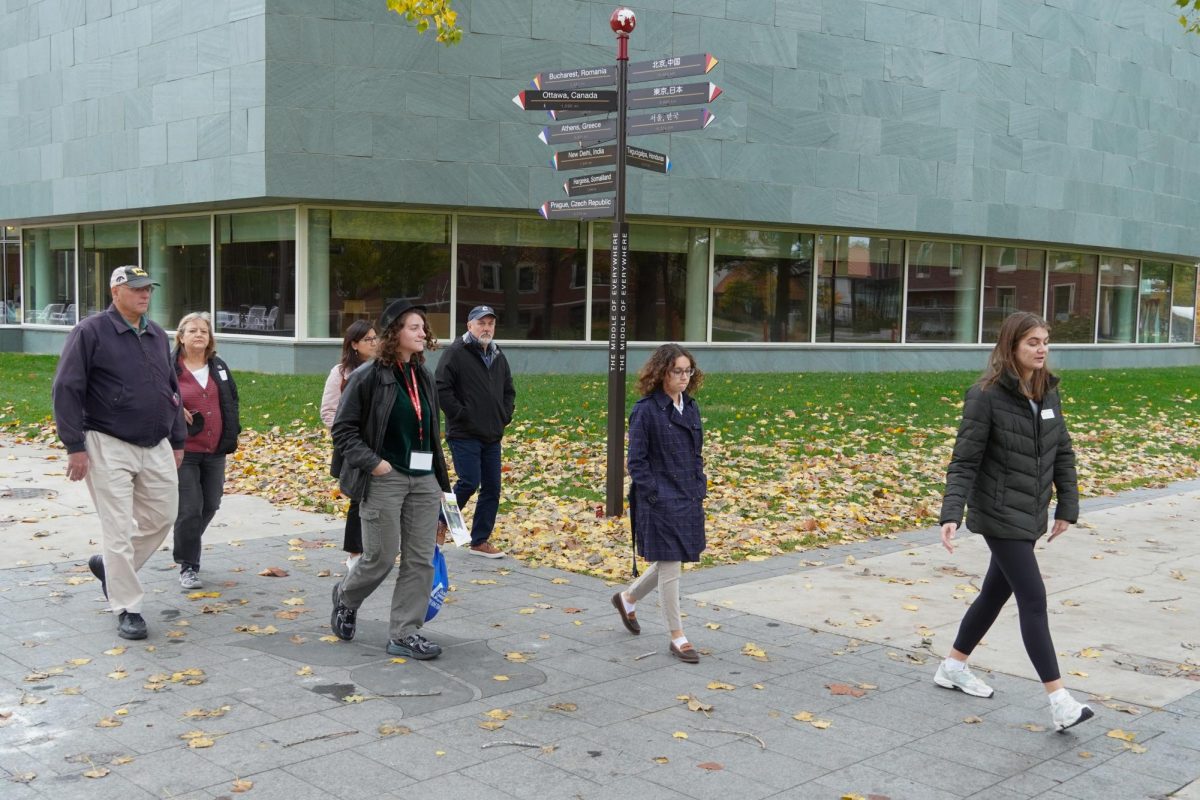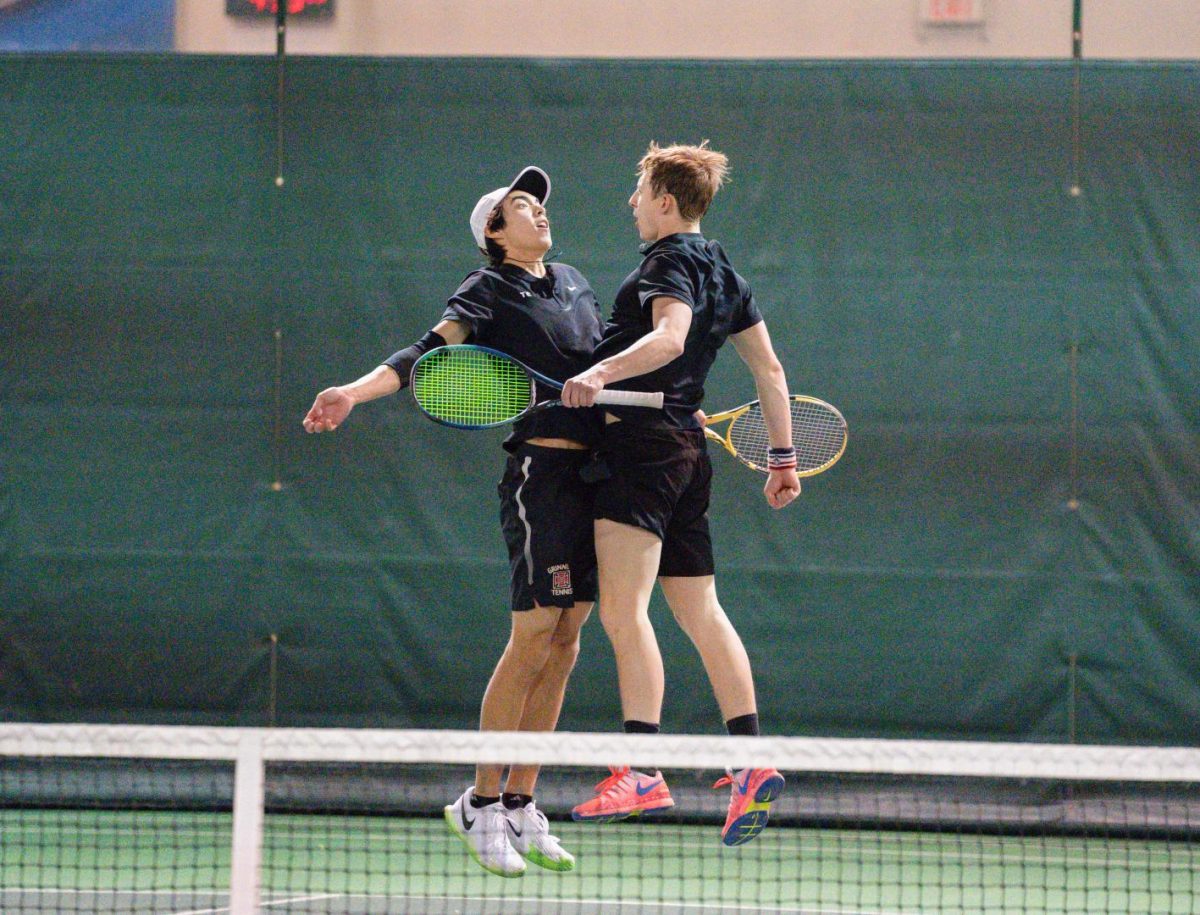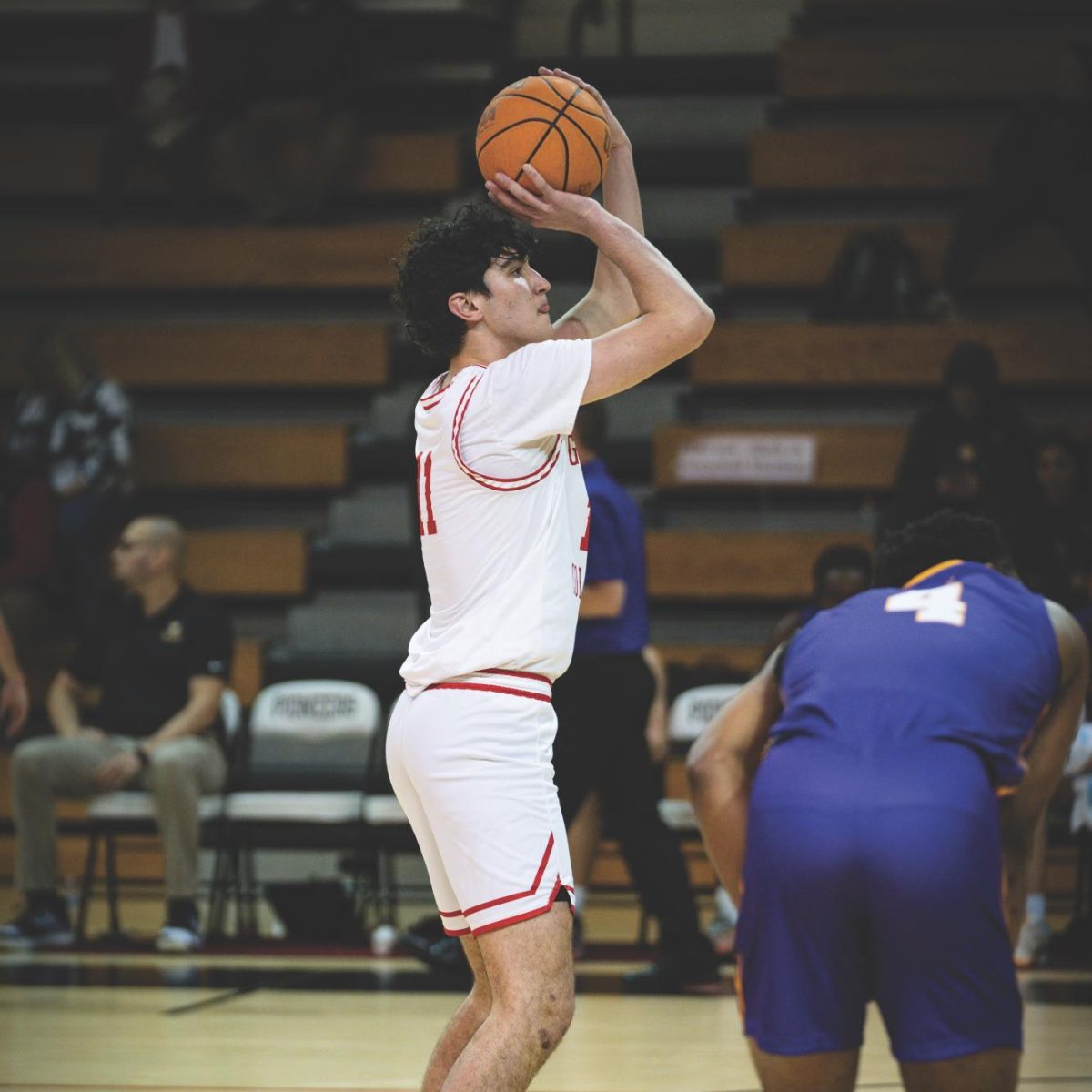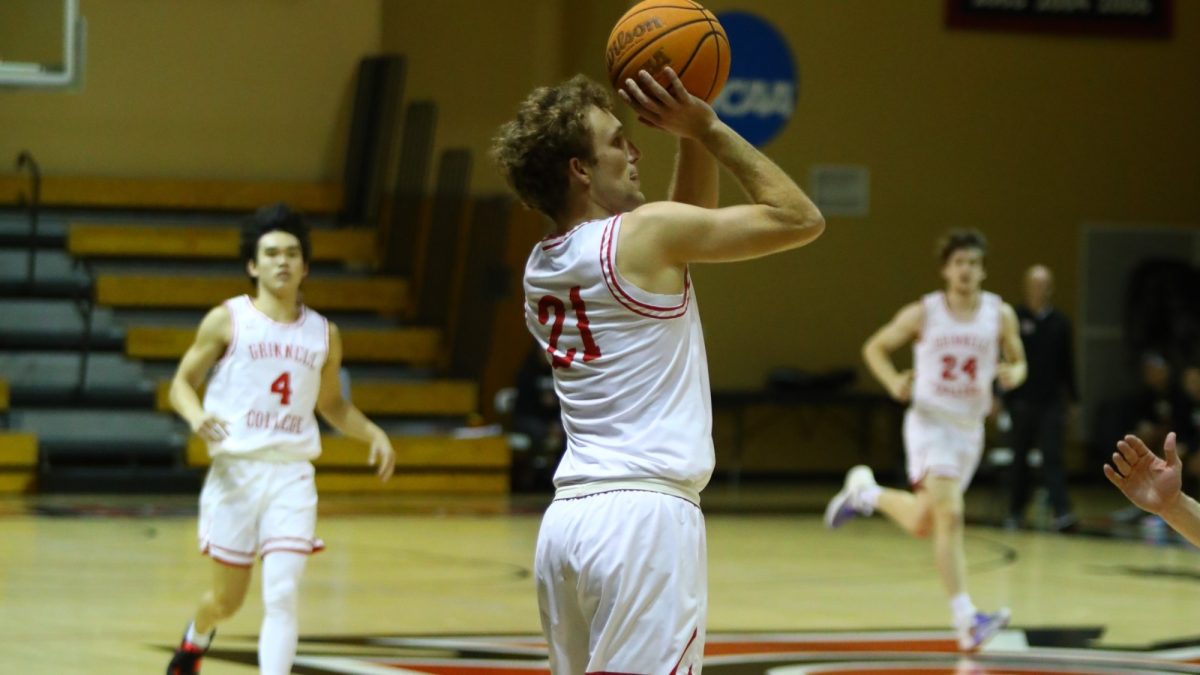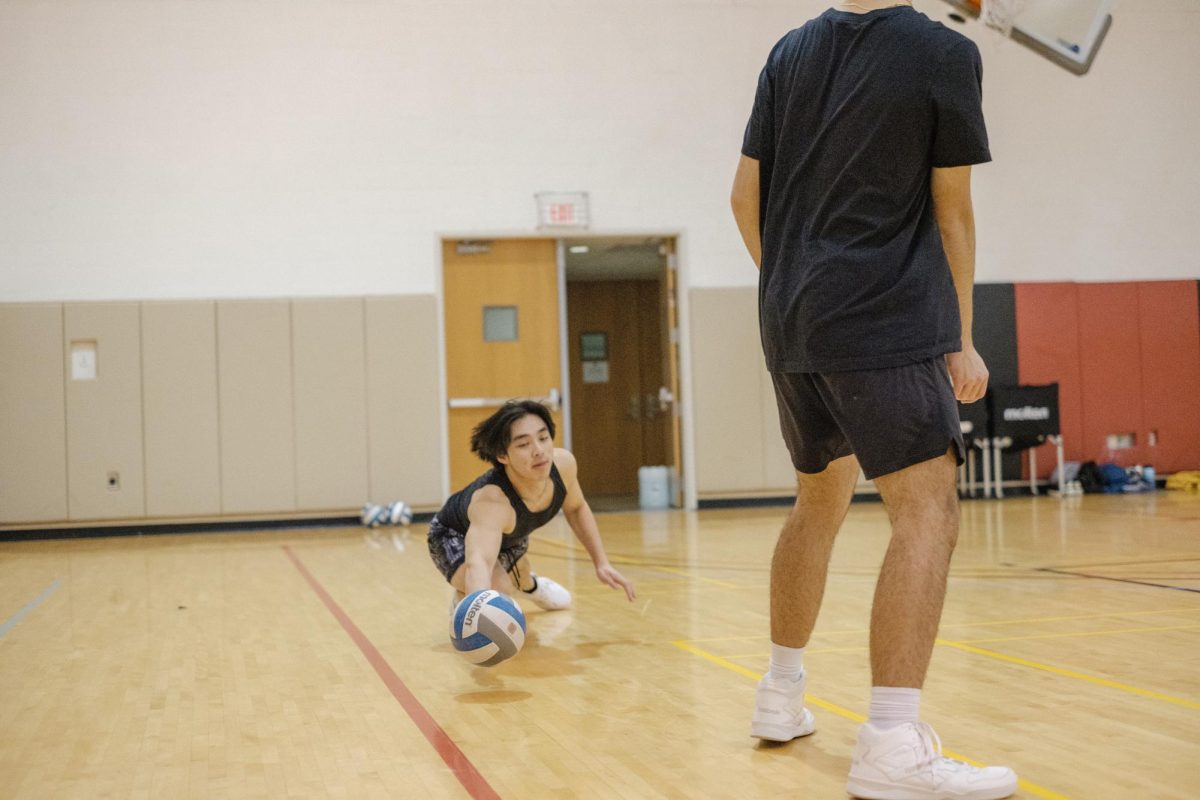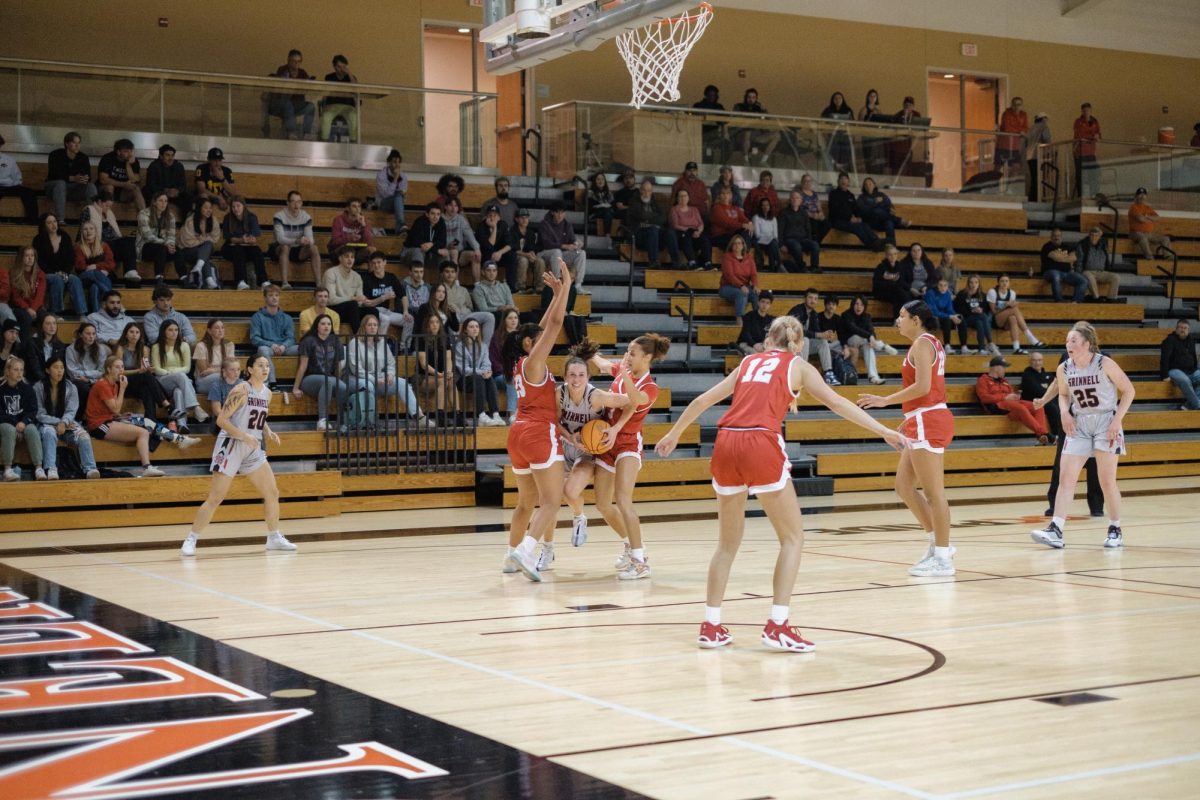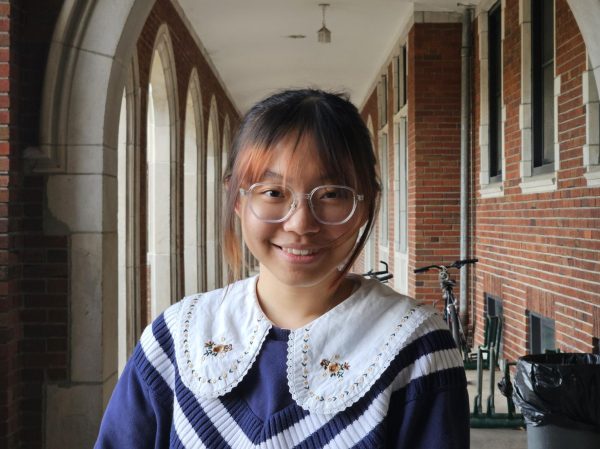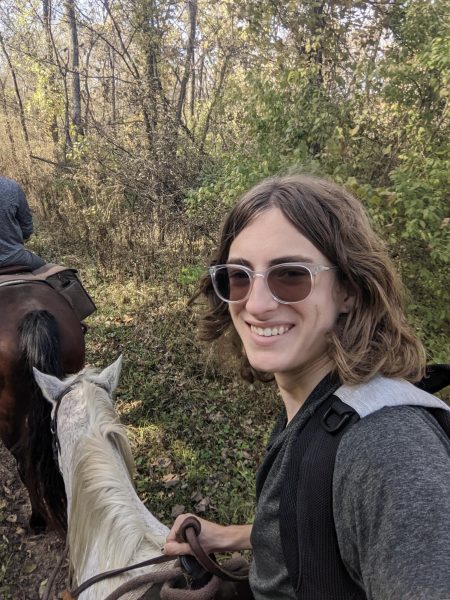During the 2022-2023 academic year, Grinnell College spent $62,043 on athletic recruitment — a year-round process underpinned by the combined, extensive efforts of team coaches, student recruiters and the Offices of Admission and Financial Aid. The aim of the game? To discover and attract the next crop of top sporting talent to rural Iowa.
A strategic recruitment process
According to head cross country coach Sarah Burnell and head tennis coach Zack Hasenyager, there are three main ways in which coaches and prospective athletes connect. First, recruitment databases and services where coaches can view profiles that high school athletes have uploaded and contact them. Second, tournaments and showcase events where students get to display their skills. And finally, phone calls and campus visits, much like every other prospective applicant. Every year, coaches receive a budget to fund these activities.
“You have a lot of autonomy to pick and choose how you spend the money,” Burnell said. Her budget is spent on database memberships, travel to recruitment events and treating prospects to food when they visit campus.
Hasenyager used his funds to travel to tournaments organized by the United States Tennis Association earlier this year. He said that coaches want to introduce Grinnell to as many prospects as possible across the country, but his efforts have focused more on regional areas like Illinois and Minnesota, and “at least once or twice” to states further out like Philadelphia and New Jersey.
Resources are at the forefront of the coaches’ decisions on what sort of recruitment practices to follow. Both coaches have described that a level of “creativity” is needed to ensure they can optimize whatever they receive with what they already have. In part, this is because the coach is usually the main and sole recruiter for their team, as Hasenyager is for the men’s and women’s tennis teams.
“It’s hard to convince the player that wants to be in the Northeast and amongst all those amazing schools to then also look at Iowa,” he said. “It’s just something that I think about — what is the best use of my time and our resources … to make sure that we’re making the most of it?”
Some coaches also have students assist with outreach and promotions as well. Diana Barba `26 works as a student recruiter for the women’s cross country team under Burnell. Barba explained that her job is to mainly follow up with prospects who have indicated interest in Grinnell and been contacted before.
It’s hard to convince the player that wants to be in the Northeast and amongst all those amazing schools to then also look at Iowa.
— Zack Hasenyager, head tennis coach
“I start off a conversation and introduce myself … I ask if they want to have a call with me as a student athlete to talk about my life here, how I came to Grinnell, stuff like that,” she said. Sometimes, Barba added, she would be tasked to look for and bring in athletes herself and accompany prospects on what are known as official campus visits.
Grinnell College is a National Collegiate Athletic Association (NCAA) Division III institution. According to NCAA recruiting rules for Division III sports, the College can only cover the expenses for one official visit per prospect. Unofficial visits can be arranged with the office of admissions at one’s own expense and are no different from the regular prospective student visits. Official visits are funded by the College, restricted by the NCAA laws and involve activities like meeting coaches and team members, touring training facilities and attending matches. This is a second factor Grinnell coaches must consider in their recruitment strategies.
“A lot of our recruiting is also limited in that way,” Burnell explained. “One of the ways I try to use my recruiting money is if a student comes, I like for them to do an unofficial visit first … if they come back for a second visit, then sometimes we’ll take them out to dinner or go get ice cream with them.”
At a small school like Grinnell, assessing a prospect’s fit with the team culture is another important factor in the recruitment process. For Barba, she uses phone conversations to figure out their characters — as athletes, students and people. She tries to figure out, “Are they going to be hardworking but also caring? Do they really love running?” Most importantly, she must ascertain, “Do they seem to really want to come here?”
“There’s a lot of schools that are very similar to others that the athletes could run at … Grinnell has a couple of downsides,” she said, referring to its small size and rural location. For instance, Barba had looked at 10 schools, all much larger than the College in size. Eventually, it was the coach and team members she met on her campus visit that made her choose Grinnell.
“If people come here, a big part of it’s going to be that they did like the team culture,” she said. If you have a strong team culture … then you’re able to all get better.”
If people come here, a big part of it’s going to be that they did like the team culture.
— Diana Barba `26, student recruiter
However, Burnell emphasized that deciding whether a prospect is fit for the team and College does not solely fall on the coaches. While she encourages interested prospects to explore Grinnell, she also ensures in her conversations that prospects can conclude for themselves early on whether Grinnell’s environment is what they are looking for, or if they should direct their efforts on other schools. “Students decide right after the first phone call,” she said. “That’s the only time I tell people, I don’t think it’s good for you to come visit.”
Coaches also factor in the numbers they want to maintain in their roster, how strong the networks within the sport are and overall, how popular the sport is. Burnell said her recruits were mostly domestic — “Running databases are not very advanced.”
Conversely, 9 of the 19 members of Hasenyager’s team hail from outside the U.S. “There are recruiting services that contact us, and that’s definitely where a lot of the international ones come from.” He explained that other sports, especially the larger and more mainstream ones like American football or baseball, might have better domestic databases such that one “could find enough people within the U.S.” For tennis, though, he tries to “spread the pool” beyond the country.
However, both coaches stressed that there are no target numbers they must meet. This is because Grinnell does not face enrollment issues and is financially stable. Burnell explained that at other schools, coaches may be evaluated on the number of students they bring into the college in order to meet enrollment targets, particularly if the school’s budgets are financed by tuition money.
“We can be a little more nuanced with it and prioritize other things than just numbers of people,” she said. “For example, in cross country, I typically look for six to eight students for both teams each year. Because to me, that’s a healthy roster size.”
A standard admissions review
Despite the flexibility afforded to coaches, the final decision on who gets admitted is made by the office of admissions and the office of financial aid.
At institutions with large sports programs that actively bring in revenue for the college, sports teams might have more sway over such important decisions. This does not happen at a Division III school like Grinnell, said Sarah Fischer, assistant vice president of admission. Coaches are allowed to make special recommendations to the director of admissions for students they feel would be a good fit for the team and the larger community, but so can professors and alumni for non-athlete prospects they feel would be a good fit for Grinnell, and that is the extent of their power over an admissions decision.
Fischer added that while “special talents” are considered, all applicants are reviewed holistically, and none are admitted based on just a single factor. However, the office of admissions can do early reads of an athlete’s academic profile to gauge their chances of admission.
“First and foremost, we want to make sure that student can be a successful Grinnell student,” she said. “Grinnell is highly selective in general, so it’s a pretty high bar all of these students have to meet.”
First and foremost, we want to make sure that student can be a successful Grinnell student. Grinnell is highly selective in general, so it’s a pretty high bar all of these students have to meet.
— Sarah Fischer, assistant vice president of admission
According to Fischer, the best thing a prospective student could do to increase their chances of admission would be to demonstrate interest. This can be done through attending information sessions or meeting with admission officers — anything that would allow the office to “know who they are.”
The round the athlete chooses to apply in is also notable. According to the College website, 53% of early decision applicants are accepted on average in comparison to 11% in the regular decision round. Fischer said that admission officers make it “transparent” that chances of admission increase if the students display their commitment to Grinnell as their top choice through the early decision plan.
“Grinnell is so competitive in regular decision,” said Burnell. “We’re essentially told we need to tell recruits, you have to go early decision.”
Joe Bagnoli, vice president for enrollment and the dean of admission and financial aid, also noted the significant effect applying early decision could have in the successful admission of an athlete. “With more than half of our spaces filled [in early decision], where the financial component of this is concerned, maybe we have less latitude in regular decision than we would have had in early decision.”
Financial aid and international recruits
As a Division III school, the College is not allowed to award athletic scholarships, only merit and financial aid. For domestic students, the admissions process is “totally separate” from the financial aid process, said Fischer, because Grinnell does not factor their financial need into the admission decision.
When it comes to international athletes, however, the process becomes more complicated — the College is need aware for international applicants. In this situation, international admission officers work with financial aid officers in deciding who to admit, Fischer said.
“If you talk with coaches … most would say they have advocated for an international student who was not admitted,” said Bagnoli. “And the reason for that would be because we’re trying to assemble the most diverse class of qualified international students.”
To achieve this aim, Bagnoli explained, holistic reviews are conducted of how the different aspects of an international applicant’s profile come together and potentially contribute to the vibrancy of the community. International applications are considered in a separate process from the domestic pool.
However, he highlighted that admitted international athletes generally received the same amount of financial support as their domestic peers — 20% of the student population is international, and they contribute 25% of the net tuition revenue, a figure that is lower than many other peer institutions.
“It’s not that we’re only willing to admit international students that are in a position to pay the full cost of attendance,” he added.
Recruiting into the future
While Hasenyager and Burnell said they believed that they were managing well in recruiting a good number of talented athletes, domestic and international, and both also said that there was always room for growth.
“We have a lot of coaches who are really excited about Grinnell, this really great school,” said Burnell. “A lot of our peer schools that are also great academic schools also have good athletics, and I think we would like to see just a bit more of an athletic presence.”
She suggested more funds could be allocated towards planning and funding visits in order to connect with more prospective athletes in person.
Hasenyager, sharing the same sentiment, noted that while he has been receiving a comfortable amount of resources, many prospective athletes are still unable to access such.
“It’s definitely a challenge, not only from a money perspective, but a time perspective.”
Burnell also expressed hopes there could be more funds allocated towards athletics at Grinnell — not just for recruitment, but to facilitate more opportunities for student athletes to grow and develop in their sport.
“I believe students can be really good at running and be really good in the classroom too,” she said. For example, Carleton College, one of Grinnell’s peer institutions, has a women’s cross-country team that has been ranked fourth in the nation by the USA Track and Field and Cross Country Coaches Association this year, while Grinnell is ranked eighth regionally. “Why aren’t we ranked third or fifth?”
“It’s hard to compete with those schools when their athletic programs are flying their students across the country to compete … we’re restricted, that’s just not quite possible with the budget I have.”
On the other hand, Hasenyager stated an observation that technology has greatly improved connectivity between coaches and recruits, leveled the recruitment playing field and intensified the recruitment process. Where in the past the schools with full-time coaches and better locations simply had the upper hand, he now has a wider pool of contacts.
“It’s made it simultaneously easier and harder … it makes it larger, the pool that you have to sort through,” he said. “The level of competition for recruits has increased … you always feel this pressure to do more … because it never stops.” While his workload has increased over the years – “there’s never enough time,” he said. He added that he welcomes such change and, like Burnell, looks forward to even more.
“Larger budgets would help to create more of a national, international presence as opposed to a more regional one,” he said. “If I could say, ‘hey, come for a visit, I’m going to pay for X, Y and Z’ … maybe they’re more likely to do it.”
For Hasenyager, recruitment brings him a sense of enjoyment. “I think some coaches look at it as this slog or never-ending battle, but I just look at it as talking to people who like tennis, about tennis, about all the fun things we’re doing on the tennis court. There are worse things in the world than that.”




























































